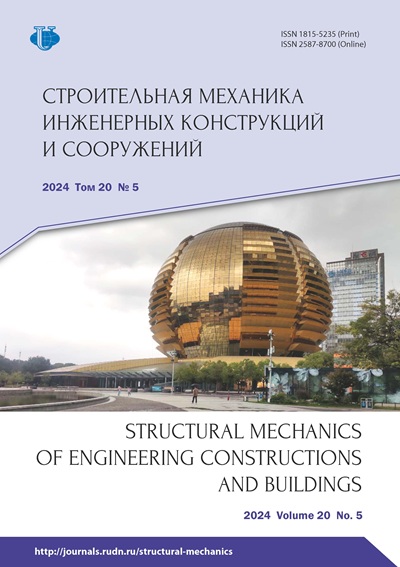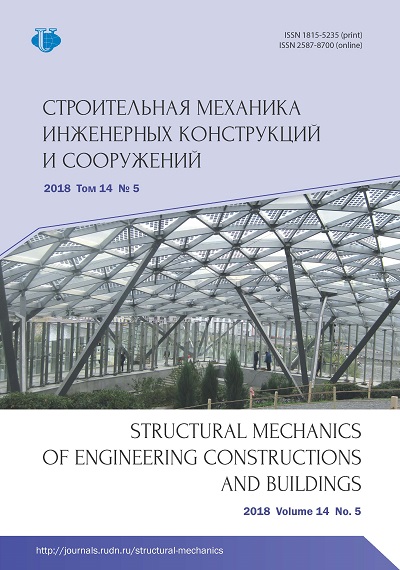Аналитическое и конечно-элементное моделирование при расчете и проектировании усилений растянутых элементов фиброармированными полимерами на основе высокопрочного волокна с применением клеевых соединений
- Авторы: Данилов А.И.1, Калугин И.А.2
-
Учреждения:
- Национальный исследовательский Московский государственный строительный университет
- ПАО РКК «Энергия»
- Выпуск: Том 14, № 5 (2018)
- Страницы: 414-426
- Раздел: Расчеты на устойчивость
- URL: https://journals.rudn.ru/structural-mechanics/article/view/20207
- DOI: https://doi.org/10.22363/1815-5235-2018-14-5-414-426
Цитировать
Полный текст
Аннотация
Предмет исследования. Анализ применимости и эффективности применения моделей различного уровня сложности для расчета и проектирования усиления растягиваемых элементов путем наклеивания на их поверхности полимеров на основе высокопрочных волокон. Цель исследования. Определение необходимого уровня сложности расчетной модели путем сравнения полученных на моделях различной сложности численных результатов в рамках упругого поведения материалов и анализ особенностей упругопластической работы в случае повышенной нагрузки. Материалы и методы. Рассматривается несколько относительно простых вариантов конструкции усиления высокопрочными волокнами с применением четырех конечно-элементных моделей (КЭ-моделей) различной сложности и аналитического подхода. В представленной серии численных экспериментов с применением ПК «ЛИРА» (СКАД) и FEMAP (NASTRAN) использовались двумерные и трехмерные КЭ-модели. Сравнение результатов упругого расчета различных КЭ-моделей с результатами, полученными с помощью аналитических выражений. Результаты расчета представлены в графической и табличной форме. Нелинейный анализ обнаруживает некоторые особенности поведения усиленных элементов при запредельных нагрузках. Результаты. Рассмотрено влияние различных факторов на работу клеевого соединения, применение уравнений и формул для расчета и проектирования. Результаты на основе аналитического подхода хорошо согласуются с результатами расчета методом конечных элементов (МКЭ). Расчеты МКЭ в физически нелинейной постановке обнаруживают некоторые особенности упругопластической работы соединений. Выводы. Все рассмотренные в статье КЭ-модели и приближенный аналитический подход в пределах упругого расчета дают близкие результаты. Наиболее экономичным по затратам усилий и времени на стадии предварительной оценки влияния различных параметров на работу узла в упругой стадии является аналитический подход. Применение МКЭ в упругой стадии целесообразно для уточнения результатов. Упрощенные плоские модели здесь достаточно надежны. Однако за пределами упругости материала усиливаемого элемента проявляются некоторые особенности НДС, не наблюдаемые в упругой стадии его нагружения и требующие особого внимания и уточненного расчета МКЭ.
Ключевые слова
Об авторах
Александр Иванович Данилов
Национальный исследовательский Московский государственный строительный университет
Автор, ответственный за переписку.
Email: alenk904@mail.ru
кандидат технических наук, доцент кафедры металлических и деревянных конструкций
Ярославское шоссе, 26, Москва, Российская Федерация, 129337Иван Александрович Калугин
ПАО РКК «Энергия»
Email: kalugin_93@bk.ru
бакалавр, инженерконструктор
ул. Ленина, 4А, Королев, Московская область, Российская Федерация, 129337Список литературы
- Овчинников И.И., Овчинников И.Г., Чесноков Г.В., Татиев Д.А., Покулаев Д.В. Усиление металлических конструкций фиброармированными пластиками // Науковедение. 2014. № 3. С. 1– 23.
- Туснин А.Р., Щуров Е.О. Экспериментальные исследования клеевого соединения элементов из стали и углепластиковых композиционных материалов // Промышленное и гражданское строительство. 2017. № 7. С. 69–73.
- Туснин А.Р., Щуров Е.О. Экспериментальные исследования стальных элементов, усиленных углепластиковыми композиционными материалами // Промышленное и гражданское строительство. 2017. № 9. С. 25–29.
- Данилов А.И. Концепция управления процессом разрушения строительного объекта // Промышленное и гражданское строительство. 2014. № 8. С. 74–77.
- Tavakkolizadeh Saadatmanesh H. Fatigue strength of steel girders strengthened with carbon fiber reinforced polymer patch // Journal of Structural Engineering, ASCE. 2003. No. 129. Pp. 186–196.
- El-Tawil S., Ekiz E., Goel S., Chao S.-H. Retraining local and global buckling behavior of steel plastic hinges using CFRP // Journal of Constructional Steel Research. 2011. No. 67. Pp. 261–269
- Tsouvalis N.G., Mirisiotis L.S., Dimou D.N. Experimental and numerical study of the fatigue behaviour of composite patch reinforced cracked steel plates // International Journal of Fatigue. 2009. No. 31. Pp. 1613–1627.
- Shaat A., Schnerch D., Fam A., Rizkalla S. Retrofit of steel structures using fiber reinforced polymers (FRP): state-of-the-art. Centre for Integration of Composites into Infrastructure. 2003.
- Nguyen T.C., Bai Y., Zhao X.L., Al-Mahaidi R. Mechanical characterization of steel/CFRP double strap joints at elevated temperatures // Composite Structures. 2011. No. 93. Pp. 1604–1612.
- Bocciarelli M., Colombi P., Fava G., Poggi C. Fatigue performance of tensile steel members strengthened with CFRP plates // Composite Structures. 2009. No. 87. Pp. 334–343.
- Liu H., Al-Mahaidi R., Zhao X. Experimental study of fatigue crack growth behavior in adhesively reinforced steel structures // Composite Structures. 2009. Vol. 90. Pp. 12–20.
- Harries K.A., Peck A.J., Abraham E.J. Enhancing stability of structural steel sections using FRP // ThinWalled Structure. 2009. Vol. 47. Pp. 1092–1101.
- Patnaik A.K., Bauer C.L. Strengthening of steel beams with carbon FRP laminates: Proceeding of the 4th Advanced Composites for Bridges and structures conference. Canada: Calgary, 2004.
- Colombi P., Bassetti A., Nussbaumer A. Analysis of cracked steel members reinforced by prestressed composite patch // Fatigue Fract. Eng. Mater. Struct. 2009. Vol. 26. No. 1. Pp. 59–67.
- Täljsten B., Hansen C.S., Schmidt J.W. Strengthening of old metallic structures in fatigue with prestressed and non-prestressed CFRP laminates // Construction and Building Materials. 2009. Vol. 23. No. 4. Pp. 1665–1677.
- Ghafoori E., Motavalli M., Botsis J., Herwig A., Galli M. Fatigue strengthening of damaged metallic beams using prestressed unbonded and bonded CFRP plates // International Journal of Fatigue. 2012. Vol. 44. Pp. 303–315.
- Ghafoori E., Schumacher A., Motavalli M. Fatigue behavior of notched steel beams reinforced with bonded CFRP plates: determination of prestressing level for crack arrest // Engineering Structures. 2012. Vol. 45. Pp. 270–283.
- Ghafoori E., Motavalli M. Flexural and interfacial behavior of metallic beams strengthened by prestressed bonded plates // Composite Structures. 2013. Vol. 101. Pp. 22–34.
















